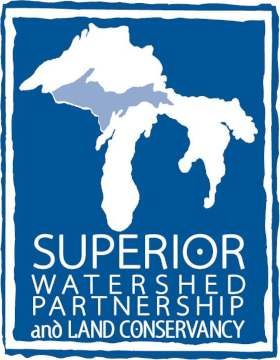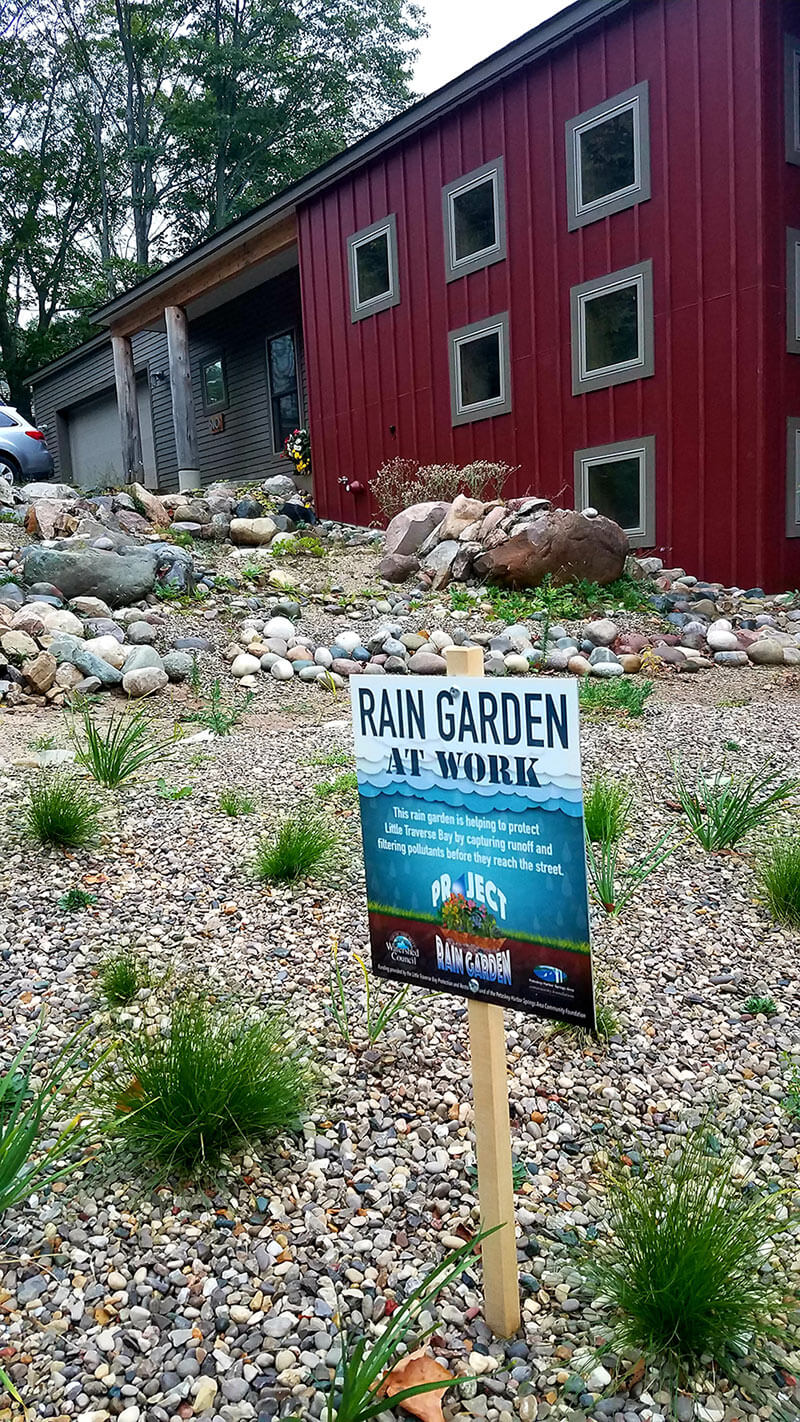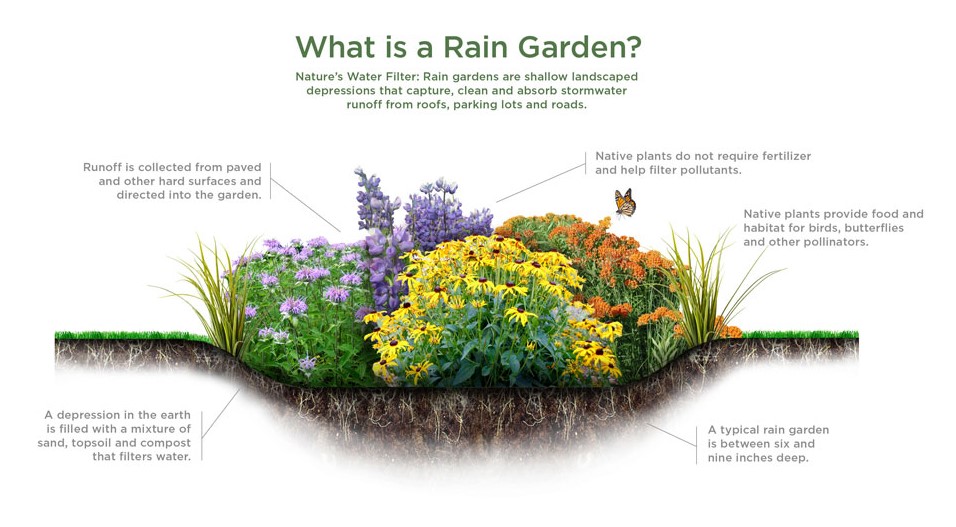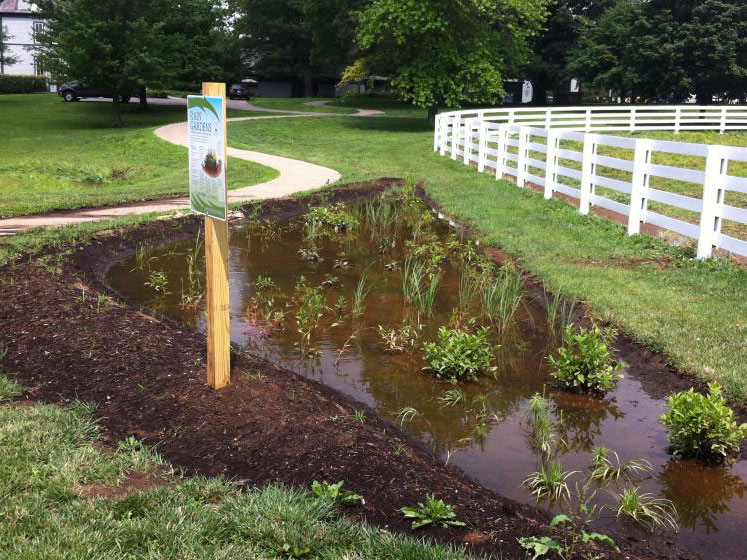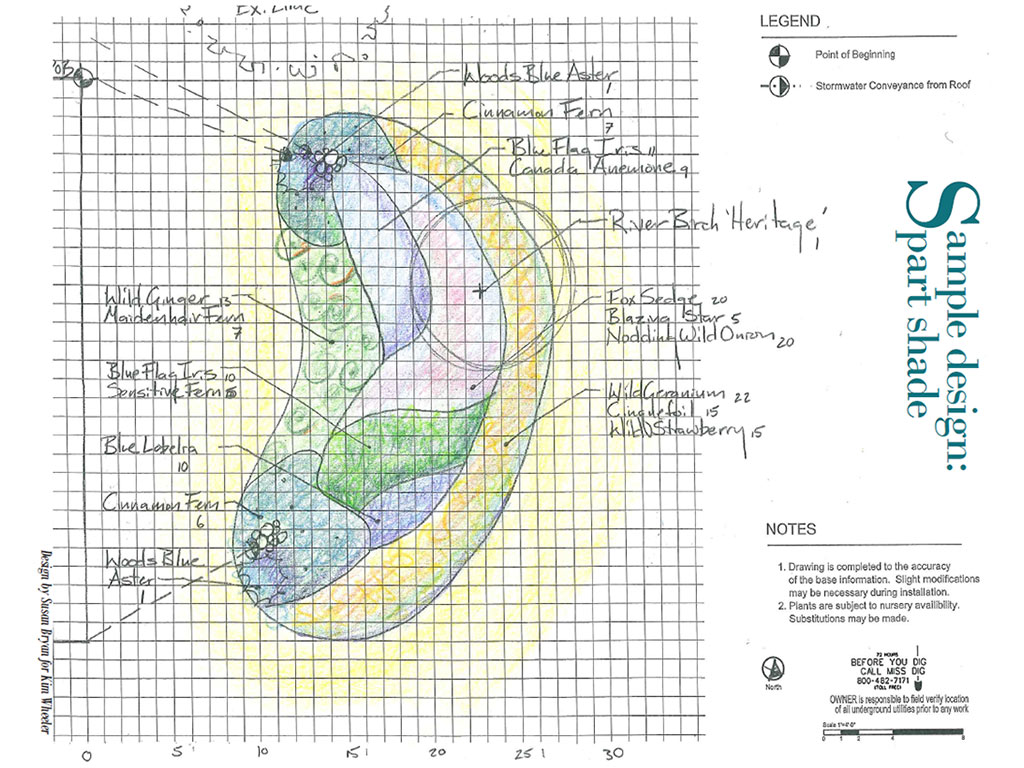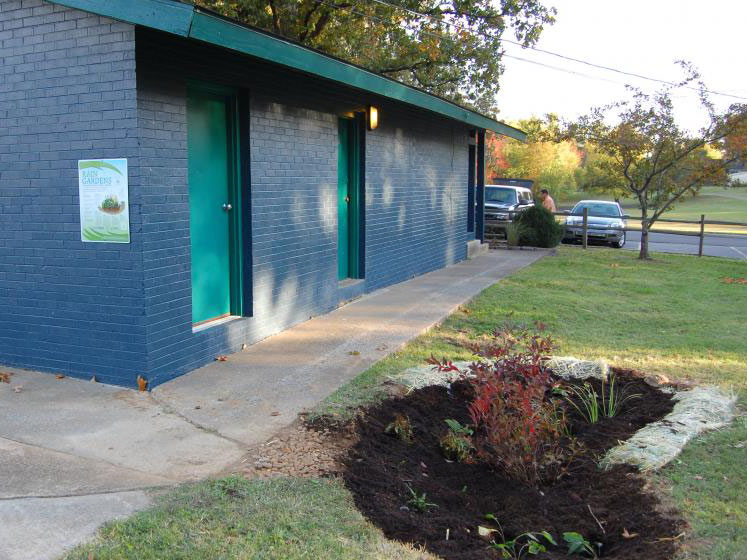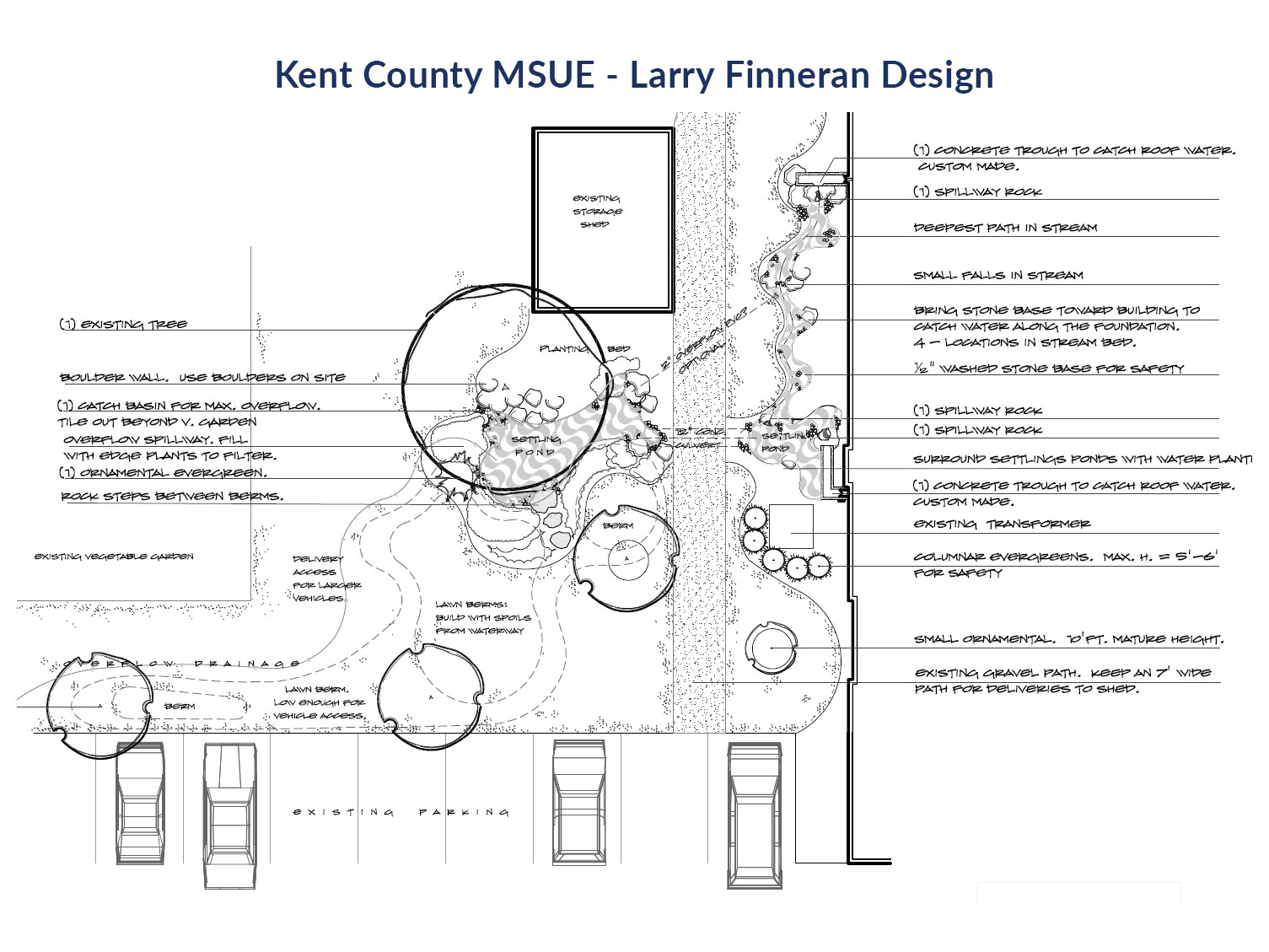Lake Superior Rain Garden Challenge
Protecting the Great Lakes, One Rain Garden at a Time
Great Lakes One Water (GLOW) Partnership
If you design and install a rain garden on your property, you could earn funds to support your contribution to Lake Superior protection.
The Lake Superior Rain Garden Challenge promotes the use of rain gardens as one way to protect the Great Lakes in the City of Marquette. The Project will provide $2,000 each for three residential rain gardens and $3,000 each towards two commercial or institutional rain gardens in 2020.
Did you know?
Rain gardens are a sustainable and cost-effective way to absorb stormwater, avert flooding, and prevent harmful pollutants—such as lawn fertilizers and pesticides, automotive fluids, and dirt and debris—from entering the Great Lakes.
Why participate?
Rain gardens can help relieve the impacts of stormwater on your own property while helping others learn about rain gardens and encouraging neighbors to create their own.
How to Size a Rain Garden
1) Measure the length and width of the impervious surfaces (roof or driveway) that will flow to your rain garden. Multiply length time width to find the area in square feet.
2) Design the garden to be 3-6’’ deep and 20-30% the size of the impervious surfaces.
3) To figure out the exact size of your rain garden, first test your soil permeability by digging a hole that is the width of your shovel and 18’’ deep. Fill with water, wait until dry. Fill the hole again with water and time the rate of infiltration.
4) If your hole drains within 24 hours, then you will want your rain garden to be 20% the size of your hard surfaces and the depth to be between 4 and 6 inches. If the hole takes longer than 24 hours to drain, size it at 30% your impermeable surface area and a depth of 3”.
Funding for the Lake Superior Rain Garden Challenge is provided through the Great Lakes One Water (GLOW) Partnership with support from the Great Lakes Protection Fund, Ralph C. Wilson, Jr. Foundation, and Kresge Foundation. Local partners include the Community Foundation of Marquette County, the Superior Watershed Partnership, Michigan State University Extension, City of Marquette, Marquette Township, and Marquette County Health Department.

How Do I Build a Rain Garden?
Lake Superior Rain Garden Challenge
Applications Due May 15, 2020
Note: Applications will be received through May 15, 2020, with the grant recipient selected by June 15. In total, three residential rain gardens and two commercial or institutional rain gardens in the City of Marquette will receive assistance.
Introduction
The Lake Superior Rain Garden Challenge promotes the use of rain gardens as one way to improve stormwater quality and protect the Great Lakes. The project will provide material, labor, and technical design funding assistance for three residential rain gardens (up to $2,000 each) and two commercial or institutional rain gardens (up to $3,000 each) in the City of Marquette in 2020. A rain garden that is funded by this grant will serve as a demonstration project to help others learn about rain gardens and encourage people to create their own rain garden. Therefore, grant recipients must agree to allow GLOW partners to promote the rain garden for educational purposes as follows:
- Photo document your rain garden at various stages that may include before, during, and immediately after installation, as well as subsequent years to monitor its progress;
- Allow the rain garden details and photos to be published online, including a project website, social media, and/or other publications; and
- Display a "Protecting the Great Lakes, One Rain Garden at a Time!" sign in the rain garden as provided by the GLOW Partnership.
Applications and Project Awards
- Applications will be received through May 15, 2020, with awardees selected by June 15.
- Award funding requires a 10% cash match (e.g., a project with a total cost of $2,000 will require $200 paid by the property owner).
- The process includes:
- A review of the submitted residential or commercial/institutional rain garden application based on eligibility standards and evaluation criteria.
- A site visit in early spring to determine if the proposed location is suitable for a rain garden. For example, the site should be strategically located to collect as much impervious area runoff as possible. Often, this means utilizing low-lying areas where water naturally drains but does not pool. See the eligibility and evaluation criteria sections below for more information.
- If selected for funding, the Superior Watershed Partnership and a qualified landscape professional will work closely with individual awardees to plan and implement each rain garden. With awardee input and site needs considered, the SWP will work to source plants, materials, and equipment/contractor support as needed and within the scope of the project budget. The SWP’s Great Lakes Conservation Corps will be available to implement each rain garden project during spring/summer 2020.
- NOTE: Direct expenses by the property owner/awardee should be avoided unless absolutely necessary and discussed with the grant contact prior to purchase. Any agreed upon expenses by the property owner/awardee will require copies of receipts for reimbursement.
Eligibility
The following criteria are the minimum eligibility standards that must be met for the application to be considered:
- The project is within Marquette’s city limits and will be located on residential, commercial, or institutional property.
- Applications must be submitted by the property owner.
- The rain garden is designed in a way that will reduce stormwater runoff from the site and improve water quality.
- The rain garden is highly visible from the public right-of-way to support awareness/education.
- Plant materials to be used are in accordance with City of Marquette Land Development Code—Section 54.1004 Standards for Plant Materials.
Criteria to evaluate the applications
- Ability to help address localized stormwater issues.
- Amount of impervious surface area treated by the rain garden. Examples of impervious surfaces include streets, roofs, parking lots, paved driveways, patios, etc.
- Creativity of design and application of appropriate design basics.
- Visibility of the site for furthering awareness of green stormwater infrastructure techniques.
- Selection of plant species.
- Presence or absence of other stormwater treatment best practices on site.
- Other unique features as presented by the applicant.
Eligible Expenses
The Lake Superior Rain Garden Challenge will fund project expenses up to a maximum of $2,000 for residential projects and $3,000 for commercial (small business) or institutional (school, office building, etc.) projects. Project funding requires a 10% match paid by the applicant. The following items are eligible expenses
- Perennial plants, seeds, or native cultivars.
- Shredded hardwood mulch.
- Soil amendments.
- Materials to connect the impervious area runoff to the rain garden.
- Labor and equipment rental costs.
*NOTE: The Superior Watershed Partnership will work with each awardee and a landscape professional to source plants, materials, and equipment/contractor support as needed and within the scope of the project budget. Direct expenses by the property owner/awardee should be avoided unless absolutely necessary and discussed with the grant contact prior to purchase. Any agreed upon expenses by the property owner/awardee will require copies of receipts for reimbursement. Only expenses incurred AFTER the notification of a grant award will be considered for reimbursement.
Any reimbursement requests must include:
- Receipts for materials and services purchased (a form will be provided)
- An itemized list of any donated materials and their value.
All reimbursement requests for projects completed must be submitted no later than December 31, 2020. Costs incurred before the project was approved will not be reimbursed.
Information about Selecting Plant Materials
It is often best to select native plants for your garden—plant species that flourished in Michigan prior to European settlement. Native plants can be found for every type of environment, from dry and sunny to soggy and shady. With their variety of colors, heights, foliage, and bloom times, they can add beauty and interest to any landscape. Native plants:
- Are naturally adapted to the soils and weather conditions of the area, so they need little care once they've become established. If they're planted in the proper location, they do not need
fertilization, irrigation, or winter protection. - Provide food and cover for wildlife. Native plants attract butterflies, dragonflies, birds, and a host of other pollinator species to a garden.
- Have deep roots that provide a path for water to seep into the ground, thereby slowing runoff and limiting soil loss from the site.
For a list of regional native plants including grasses, wildflowers, shrubs, and trees, refer to:https://www.canr.msu.edu/nativeplants/plant_facts/local_info/upper_peninsula
Based on the undesirability of the following species, they are prohibited from being planted as required landscaping under the City of Marquette Land Development Code (Section 54.1004(C)):
- Ash
- Aspen
- Black Locust
- Blue Spruce
- Box Elder
- Buckthorn
- Cottonwood
- Elm
- Ginkgo (Female)
- Honey Locust (with thorns)
- Honeysuckle
- Horse Chestnut (nut bearing)
- Jack Pine
- Multiflora Rose
- Norway Maple (unless a specific species is acceptable)
- Olive
- Phragmites
- Poplar
- Purple Loosestrife
- Silver Maple
- Tree of Heaven
- Willow
- Any species of plant deemed to be a noxious species by a City Code or City Official qualified to deem a species as noxious.
Landscape Contractors
With design and construction oversight from a qualified landscape professional, the Superior Watershed Partnership will provide Great Lakes Conservation Corps (GLCC) crews to implement each rain garden. There is a reduced cost for their services that will be applied to the project cost. Alternatively, if preferred by the awardee, other area landscapers may be utilized to complete project objectives. However, plans and associated costs must be discussed with the grant contact prior to implementation. Any agreed upon expenses by the property owner/awardee will require copies of receipts for reimbursement.
Questions? Please Contact:
Abbie Hanson
Biologist, Project Planner
Superior Watershed Partnership
2 Peter White Drive, Marquette, MI 49855
(906)228-6095 ext. 11
